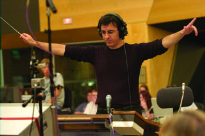Level 6 Compose Yourself!: The Art of Composing for Games
Learning Outcomes
- Identify differences between linear and non-linear music composition
- Examine the use of loops, branching, and transitions
- Recognize the factors involved in non-linear scoring
- Understand vertical and horizontal musical concepts
Challenges in Music Creation for Media
- Music composition varies across mediums
- Unique challenges in theater, film, television, and games
- Specific issues faced by game composers
- Solutions and strategies for effective game music composition
Evolution of Video Game Music Composition
- Origins and challenges in early video game music
- Transition to digital music generation in the gaming industry
- Development and constraints of early game music technology
- Technological advancements and their impact on game music composition
Modern Game Music Composition
- Role and skill set of contemporary game-music composers
- Technological advancements shaping game music
- Team structures and specialization in music production for games
- Versatility and challenges in current game music composition
Impact of Music in Video Games
- Setting the mood and tone
- Defining time and place
- Distinguishing locations and settings
- Character identification through music
- Influencing gameplay pace
- Enhancing player immersion
Journey (2012)
Game Music Form and Structure
- Cinematic
- Music underscores cutscenes, intros, and other story-driven sequences, heightening emotional impact and narrative flow.
- Interactive Gameplay
- Looping: a continuous repetition of material that supports long gameplay segments without fatigue (e.g., exploration themes in Minecraft).
- Branching: conditional transitions triggered by player actions or game states (e.g., battle-to-victory shifts in The Legend of Zelda: Breath of the Wild).
- Layered/Stem Mixing: dynamic addition or removal of instrument layers to match intensity (e.g., combat music in Hades).
Horizontal vs vertical re-orchestration
See examples here
Vertical Remixing – Layering
Horizontal Re-sequencing
- Concept of Horizontal Re-sequencing
- Techniques within Horizontal Re-sequencing
- Implementation in Video Games
Cross-fading
Phrase Branching
Musical Demarcation Branching
Bridge Transition
Stinger-Based Sequencing
Fallout 4
The Music Team
- Music director
- Oversees the creative direction of the music for a game
- Meets with composers, game designers, programmers, and all other members of the production team to draft a creative vision
- Music producer
- Controls the creative vision of the musical recording itself
- Works with all the members to hire the musicians and engineers

The Music Team
- Composer
- Writes music, working in collaboration with the music director and producer to match the creative vision of the game
- To create the score, the composer may use a computer-sequencing program such as Pro tools or Logic, or even, in some cases, pen and paper
The Music Team
- Orchestrator
- Takes the music from the composer and either makes MIDI orchestrations or prepares parts and scores so that live humans can play the music if need be
- Works with notation programs such as Finale and Sibelius to get the music ready for recording
- Recording engineer
- Deals with the nuts and bolts of recording the music for a game
- Records anything from live instruments to singers and needs a good working knowledge of recording studio technology and digital editing software
The Music Team
- Mix engineer
- Takes the completed recordings from the studio and balances the instruments and parts to make sure the recorded elements sound great together in the game
- Mastering engineer
- Produces and delivers the final tracks in the desired format for the game
- Has great ears and keen understanding of the platform the music will be integrated into